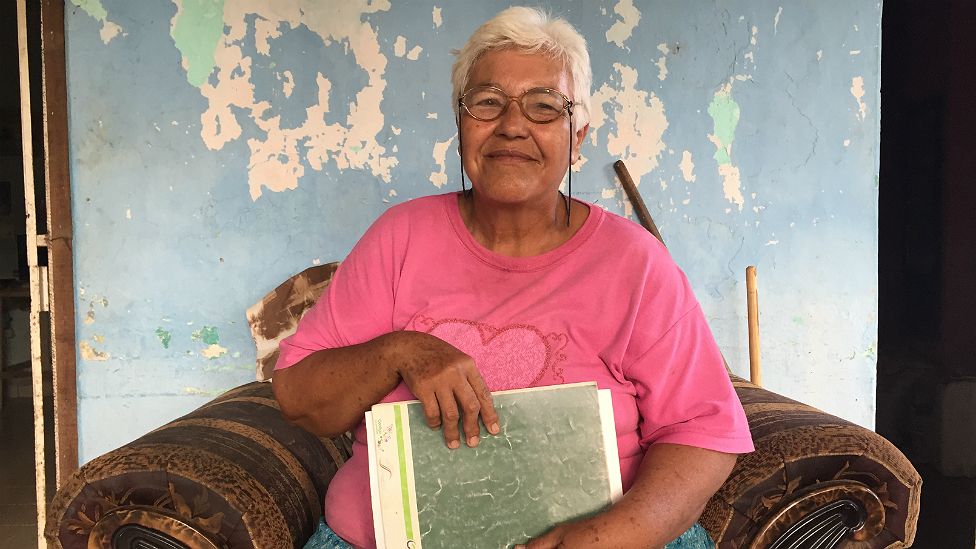San Marcos: The flooded town Mexicans refuse to leave
- Published

Hortensia Gutierrez remembers the screams and whispering to her sleeping husband that it sounded like someone was being killed.
No one was murdered that night in 2009, but panic spread as the Mexican town of San Marcos was submerged in water.
The huge Picachos dam, 7km (four miles) away, had flooded during construction work, a disaster that some residents had foreseen.
Six small communities in Sinaloa, north-west Mexico, were devastated and 800 families were displaced.
For years afterwards, Picachos became synonymous with the residents' fight for compensation, for their lost land and livelihoods.
The vast majority of those who lived in the area moved away long ago, but not everyone wanted to leave.
Eight years on, a handful of people still live among the ruins.
Cipriano Osuna, known as Pani, never thought of going anywhere else, because his family had lived in San Marcos for generations.
Every day, he still works on repairing the local church, even though it lost its priest and congregation long ago.
He paints it and turns on the lights, just in case someone passes by.
It is a special place for Pani, where he was baptised, took his first communion, got married, and later baptised his children and grandchildren. Every year, on the anniversary of his father's death, he hires a priest from a neighbouring village to say mass.
"A lot of people think I'm crazy to stay. I don't care what they think," he says.
Although it hurts him to be constantly reminded of the losses, he insists life goes on much as it ever did. "I live at ease here. Who has been killed by loneliness?"
Pani's only neighbours are Yoya and Jaimito.
"When you go to the new San Marcos now, they look at us as if we are strange," says Yoya, whose real name is Maria Aura Lamphar.
The "new San Marcos" is where almost all of the 300 inhabitants of the first San Marcos went.
Just a kilometre separates the two San Marcos, but they feel worlds apart.
"[The others] went there and, according to them, they improved. We stayed and we didn't," Yoya says, laughing.
There is not much to do in this semi-abandoned area. In the rainy season, it is still partially submerged in water.
But Yoya says she is happy, religiously respecting her routine.
She keeps herself busy by doing household chores, watering the plants, sewing, watching the TV and reading the Bible.
And while Yoya has learnt to enjoy loneliness, Ramiro Osuna fights it every day.
He has lived in the area for 50 years. "I get bored, I get angry. I would like to see the world, to see another landscape," he says.
Although he mostly lives in the new town, he still visits his old home once a week. "There is nostalgia, yes, there is nostalgia, and that's life."
The new San Marcos has a health centre, a school, a church (also without priest), one butcher and three shops, one of which is owned by Ramiro. Many of its houses remain empty.
The abandoned houses in the old San Marcos have now been invaded by the trees. The chirping of countless birds is constant.
Lorenzo, Hortensia's husband, walks around the square while a flock of crows flies through a clear sky. He stands in the middle of debris and recalls how it once was.
"It was big, very pretty. Look at the structure, it had seven bedrooms, a 12-metre corridor," he says. "It's very hard to see it like this. I slept there; my children were born here."
Lorenzo and Hortensia now live in the port town of Mazatlán, an hour's drive away, but they come to the new San Marcos once a week.
Both of them were involved in early protests against the construction of the dam and, later, became involved in the displaced persons' rights campaign.
The leader of that movement, Atilano Roman Tirado, was a close friend. He died after he was shot while presenting his radio show in Mazatlán in 2014. The bullets passed close to Hortensia, who was in the studio to sing a corrido - a traditional Mexican genre - about the Picachos dam.
"He was like a brother. I loved him," she says.
The crime was never solved.
Two years earlier, Atilano and Hortensia had walked for nine days from San Marcos to the state capital, Culiacan, to protest against what they considered to be unjust compensation for having to leave the town. Both spent weeks in prison after causing a road block.
They also organised demonstrations at the construction site, occupied the tourist areas in Mazatlán, and clashed with the police.
Local authorities insist the dam was essential for guaranteeing drinking water, producing electricity and irrigating more than 20,000 hectares of agriculture. The government say it has been doing everything it can to provide a fair compensation to everyone affected.
Hortensia still plays the same black guitar she had on the day Atilano was murdered. Her voice mingles with the bells of a couple of cows roaming the village.
She is still hurt and angry about what happened. When her guitar and singing fall silent, nothing but the birdsong of old San Marcos remains.
- Published13 July 2017
- Published4 July 2017